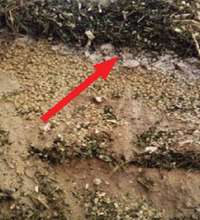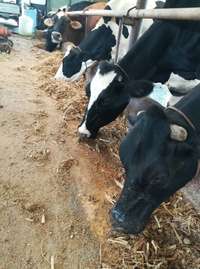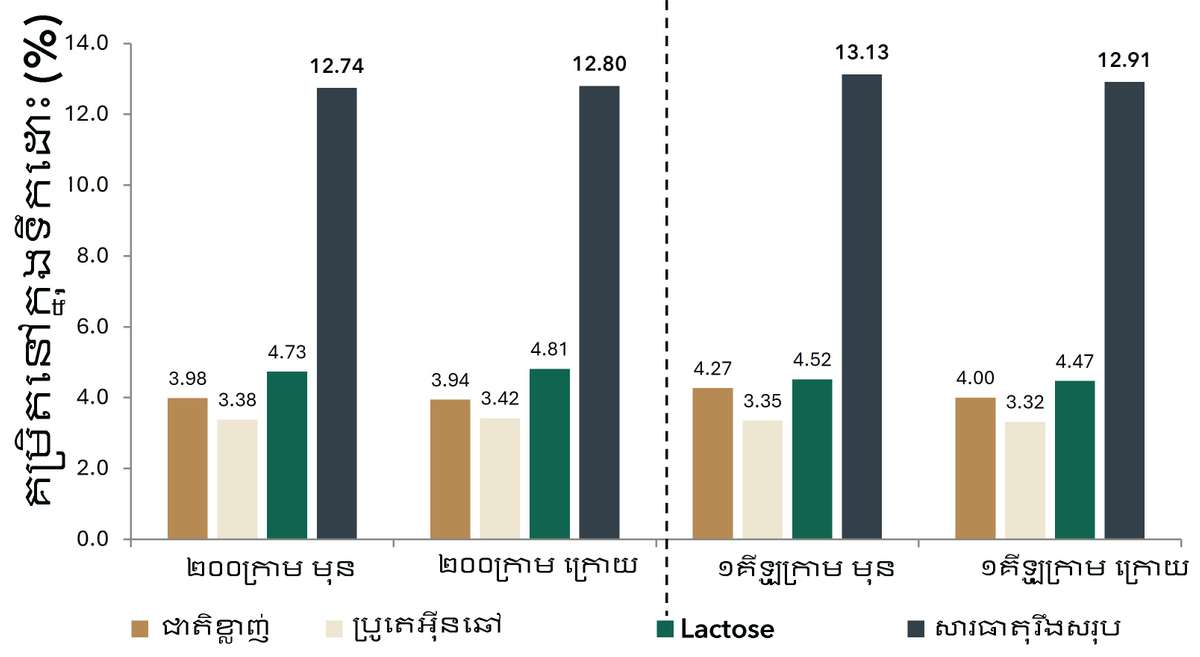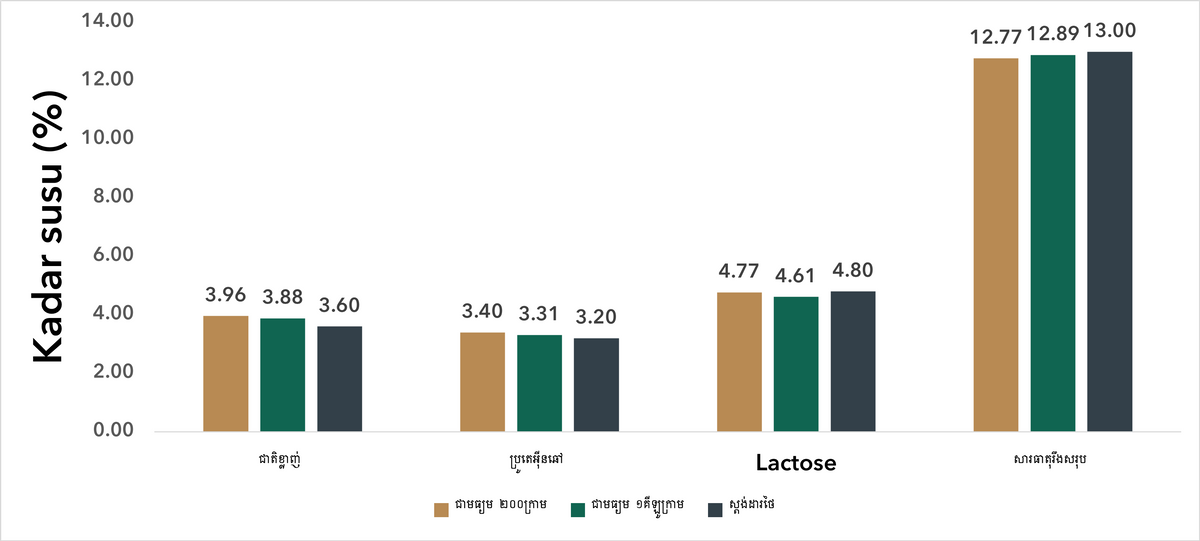អត្ថបទនេះសង្ខេបពីការស្រាវជ្រាវរបស់អេកូ ដែលផលិតឡើងដោយ Boonsong Thansrithong, Abram J. Bicksler, និង Patrick J. Trail ។
សេចក្តីផ្តើម
ទំនាក់ទំនង

ផ្លែកាហ្វេបានចែកជាពីរដោយសម្បកពណ៌ទឹកប្រាក់ និងព័ទ្ធដោយស្រទាប់សម្បកគ្រាប់ខាងក្នុង (ខាងឆ្វេង) និងគ្រាប់កាហ្វេពីរគ្រាប់ដោយគ្មានការរុំព័ទ្ធ (ខាងស្តាំ)។
ក្នុងពេលដំណាលគ្នានោ ឧស្សាហកម្មកាហ្វេសកល (Coffea spp.) ផលិតបានប្រហែល ១០.៨ លានតោននៃកាហ្វេស្រស់នៅឆ្នាំ ២០២២ (FAOSTAT, 2024) ហើយរួមជាមួយនឹងបរិមាណកាកសំណល់ដ៏ច្រើន។ សម្រាប់រាល់កាហ្វេដែលបានប្រមូលផលដោយគម្រោងអភិវឌ្ឍន៍កុលសម្ព័ន្ធជនជាតិដើមភាគតិចនៅភាគខាងជើងនៃប្រទេសថៃ ពួកគេបានរកឃើញថា តិចជាង ២៥% ដែលនាំឱ្យកាហ្វេស្រស់មានទីផ្សារ។ ភាគរយដែលនៅសល់ គឺសម្រាប់ កាកសំណល់' អនុផលទាំងនោះរួមមាន សាច់នៃសម្បកកាហ្វេ (coffee cherry pulp), សាច់គ្រាប់កាហ្វេ (mucilage), សម្បកគ្រាប់ខាងក្នុង (parchment ) និងគ្រាប់ដែលខូចបោះចោល (discarded beans )។
ជំហានចុងក្រោយក្នុងការកែច្នៃកាហ្វេស្រស់ (Coffea arabica) គឺការយកចេញនូវស្រទាប់សម្បក គ្រាប់ខាងក្នុង (parchment ) នៃគ្រាប់កាហ្វេ ដែលជាទូទៅគេហៅថា សម្បកនៃគ្រាប់ខាងក្នុង 'parchment' (រូបទី៧)។ មជ្ឈមណ្ឌលកែច្នៃកាហ្វេ យកសម្បកគ្រាប់ខាងក្នុងចេញ មុនពេលដឹកជញ្ជូន ឬលីងគ្រាប់កាហ្វេ ដោយប្រមូលចេញនូវអនុផលដែលមិនចង់បាន។ វិធីសាស្រ្តនៃការយកសម្បកគ្រាប់ខាងក្នុងចេញ រួមមានការដុត ឬទុកវាចោលជាគំនរ ដើម្បីឱ្យវារលួយ ដែលទាំងពីរនេះអាចបង្កគ្រោះថ្នាក់ដល់បរិស្ថានក្នុងទ្រង់ទ្រាយធំ។
ក្នុងពេលដំណាលគ្នានោះ ឧស្សាហកម្មទឹកដោះគោស្វែងរកប្រភពបរិមាណដ៏ច្រើននៃជាតិសរសៃរតម្លៃទាប ដើម្បីរួមបញ្ចូលក្នុងរបបចំណី។ ពួកគេប្រឈមមុខនឹងបញ្ហាជាបន្តបន្ទាប់នៃប្រាក់ចំណេញទាប និងតម្លៃសមាសធាតុចំណីដែលប្រែប្រួល។ សម្បកគ្រាប់ខាងក្នុង (parchment) មានសារធាតុសរសៃរខ្ពស់ (Negesse et al., 2009) ច្រើន ដូចជា ៨៣.៦% Neutral Detergent Fiber (NDF)3 (Vilela et al., 2001)។ ការផ្គត់ផ្គង់របស់វាច្រើនតែលើសពីតម្រូវការរបស់វា ដែលធ្វើឱ្យវាមានតម្លៃសមរម្យមួយ ប្រសិនបើមិនមានធនធានឥតគិតថ្លៃនៅក្នុងផ្នែកនានានៃពិភពផលិតកាហ្វេ។ នេះបាននាំឱ្យអ្នកស្រាវជ្រាវពិចារណាប្រើសម្បក គ្រាប់ខាងក្នុង (parchment) កាហ្វេជាសមាសធាតុចិញ្ចឹមបសុសត្វ (Didanna, 2014; Mazzafera, 2002) ។
គោលបំណងនៃការស្រាវជ្រាវ
បុគ្គលិកអេកូអាស៊ីបានធ្វើការស្រាវជ្រាវនេះ ដោយមានគោលបំណងសំខាន់ក្នុងការជំនួសផ្នែកមួយនៃសមាសធាតុជាតិសរសៃដែលបានទិញនៅក្នុងចំណីគោយកទឹកដោះ ជាមួយនឹងម្សៅកាហ្វេដោយឥតគិតថ្លៃ និងវាយតម្លៃផលប៉ះពាល់របស់វាទៅលើការផលិតទឹកដោះគោ។ ការស្រាវជ្រាវរបស់យើង គឺពាក់ព័ន្ធនឹងតំបន់ដែលសម្បកគ្រាប់ខាងក្នុង (parchment) កាហ្វេមិនមានតម្រូវការខ្ពស់ ហើយអាចទទួលបានដោយមិនគិតថ្លៃ។ កសិករដែលចាប់អារម្មណ៍លើជម្រើសចំណីនេះ ត្រូវតែគិតពីពេលវេលា កម្លាំងពលកម្ម និងថ្លៃដឹកជញ្ជូនដែលទាក់ទងនឹងការប្រើប្រាស់ធនធានកាហ្វេ។
វិធីសាស្រ្ត
យើងបានដឹកនាំធ្វើការពិសោធនេះក្នុងអំឡុងឆ្នាំ ២០១៦ និង ២០១៧ នៅភាគខាងជើងប្រទេសថៃ នៅកសិដ្ឋានទឹកដោះគោ MMM នៅ San Kampaeng ស្រុក Chiang Mai។
អាហារ

រូបទី៨. កសិដ្ឋានផលិតចំណីជាមួយនឹងសម្បកគ្រាប់ខាងក្នុងកាហ្វេមុនពេលលាយបញ្ចូលគ្នា។ ប្រភព៖ អេកូ

រូបទី9. គោយកទឹកដោះនៅ MMM Dairy កសិដ្ឋានចិញ្ចឹមគយកទឹកដោះ។ ប្រភព៖ អេកូ
ការពិសោធនេះ រួមមានការសាកល្បងពិសោធន៍ចំនួនបី។ នៅក្នុងការសាកល្បងនីមួយៗ យើងបានប្រើសម្បកគ្រាប់ខាងក្នុងកាហ្វេ ដើម្បីផ្តល់នូវផ្នែកមួយនៃសារធាតុសរសៃរបស់ចំណីដែលផលិតដោយកសិដ្ឋាន (រូបទី៨)។ សម្បកគ្រាប់ខាងក្នុងកាហ្វេដែលប្រើក្នុងការពិសោធទាំងនេះបានមកពី Coffea arabica បានកែច្នៃដោយប្រើវិធីសើម។.4 បានកែច្នៃដោយប្រើវិធីសើម។ នៅក្នុងការពិសោធលើកដំបូង យើងបានបន្ថែមសម្បកគ្រាប់ខាងក្នុងកាហ្វេ ២០០ក្រាមទៅក្នុងចំណីប្រចាំថ្ងៃរបស់គោយកទឹកដោះ Holstein ត្រូពិច ចំនួន ១៩ក្បាល ដែលបានជ្រើសរើសដោយចៃដន្យ។ នៅក្នុងវគ្គទី២ និងទី៣ យើងបានបន្ថែមសម្បកគ្រាប់ខាងក្នុងកាហ្វេ ១គីឡូក្រាម ទៅក្នុងចំណីប្រចាំថ្ងៃរបស់គោយកទឹកដោះចំនួន ១៦ក្បាល ដែលបានជ្រើសរើសដោយចៃដន្យក្នុងហ្វូងតែមួយ។ យើងផ្តល់ចំណីទៅគោនីមួយៗ ២៥គីឡូក្រាមនៃចំណីដែលបានផលិតដោយកសិដ្ឋានបន្ថែម (តារាងទី១ រូបទី៩) ក្នុងថ្ងៃនីមួយៗសម្រាប់រយៈពេលមួយខែ បន្ថែមពីលើចំណីពាណិជ្ជកម្មចំនួន ៥គីឡូក្រាមរៀងរាល់ថ្ងៃ។
| ធាតុផ្សំ | ទម្ងន់ (គ.ក្រ) |
តម្លៃ (បាត/គ.ក្រ) |
តម្លៃ (ដុល្លារ/គ.ក្រ) |
តម្លៃសរុបជាមួយសម្បកគ្រាប់ក្នុងកាហ្វេ (បាត) | តម្លៃសរុបជាមួយសម្បកគ្រាប់ក្នុងកាហ្វេ (ដុល្លារ) | តម្លៃសរុបដោយគ្មានសម្បកសាច់គ្រាប់ក្នុងកាហ្វេ (បាត) | តម្លៃសរុបដោយគ្មានសម្បកសាច់គ្រាប់ក្នុងកាហ្វេ (ដុល្លារ) |
|---|---|---|---|---|---|---|---|
| ចំណីសត្វស្រស់ពីពោត | 650 | 1.8 | 0.05 | 1,170 | 32.19 | 1,170 | 32.19 |
| ម្ស៉ៅដំឡូងមី | 400 | 1.3 | 0.04 | 520 | 14.31 | 520 | 14.31 |
| សម្បកផ្លែពោតស្ងួត | 150 | 2 | 0.06 | 300 | 8.25 | 500 | 13.74 |
| Canned Fruit Syrup | 5 | 2 | 0.06 | 10 | 0.28 | 10 | 0.28 |
| សម្បកគ្រាប់ក្នុងកាហ្វេ | 100 | 0 | 0 | 0 | 0 | N/A | N/A |
| សរុប | 1,305 | 2,000 | 55.03 | 2,200 | 60.44 |
វិធានការ
យើងបានផ្ញើសំណាកទឹកដោះគោរបស់គោនីមួយៗសម្រាប់ការធ្វើតេស្តគុណភាព មុន និងក្រោយ
ពេលមួយខែនៃការផ្តល់ចំណីឱ្យពួកវានូវចំណីសម្បកគ្រាប់ខាងក្នុងកាហ្វេ ដែលផលិតដោយកសិដ្ឋាន។ សាកលវិទ្យាល័យកសិកម្ម Maejo នៅឈៀងម៉ៃ ប្រទេសថៃ បានធ្វើតេស្តគុណភាពទឹកដោះគោ។ ពួកគេបានវាស់វែងអថេរអាស្រ័យនៃជាតិខ្លាញ់ ប្រូតេអ៊ីនឆៅ ជាតិ lactose សារធាតុរឹងសរុប និងចំនួនកោសិកា somatic ។ នាយកដ្ឋានអភិវឌ្ឍន៍បសុសត្វរបស់ប្រទេសថៃ បានជួយក្នុងការទទួលការធ្វើតេស្តនេះ។
កម្រិតប្រូតេអ៊ីនឆៅ ជាតិ lactose និងសារធាតុរឹងសរុប គឺជាសូចនាករនៃគុណភាពទឹកដោះគោ ហើយអាចរងផលប៉ះពាល់ដោយរបបអាហាររបស់គោ។ ការថយចុះនៃប៉ារ៉ាម៉ែត្រទាំងនេះនៅចុងបញ្ចប់នៃការសាកល្បងមតិ ព័ត៌មាននឹងបង្ហាញពីផលប៉ះពាល់អវិជ្ជមានដែលអាចមកពីការផ្លាស់ប្តូររបបអាហារ។
ចំនួនកោសិកា Somatic 5 ត្រូវបានប្រើជាសូចនាករនៃគុណភាពទឹកដោះគោ និងសុខភាពសត្វ។ រាល់ការកើនឡើងនៃចំនួនកោសិកា somatic នៅចុងបញ្ចប់នៃការសាកល្បងចំណី នឹងបង្ហាញពីផលប៉ះពាល់អវិជ្ជមានដែលអាចមកពីការផ្លាស់ប្តូររបបអាហារ។
លទ្ធផល
គុណភាពទឹកដោះ
មិនមានភាពខុសប្លែកគ្នាជាស្ថិតិនៅក្នុងការវាស់វែងគុណភាពទឹកដោះណាមួយមុន និងក្រោយពេលដែលគោបានទទួលចំណីដែលផលិតដោយកសិដ្ឋាន ដែលបន្ថែមជាមួយនឹងសម្បកគ្រាប់ខាងក្នុងកាហ្វេ ២០០ក្រាម ឬ១គីឡូក្រាមនោះទេ (រូបទី១០)។

ភាគរយនៃជាតិខ្លាញ់ ប្រូតេអ៊ីនឆៅ ជាតិ lactose និងសារធាតុរឹងសរុប មុន និងក្រោយការសាកល្បងពិសោធ ២០០ក្រាម និង ១គីឡូក្រាម សម្បកគ្រាប់ខាងក្នុងកាហ្វេ ត្រូវបានដាក់បញ្ចូលទៅក្នុងរបបអាហារសរុបប្រចាំថ្ងៃរបស់គោនីមួយៗ។
ការវាស់វែងគុណភាពទឹកដោះគោដែលបានមកពីការពិសោធ គឺអាចប្រៀបធៀបទៅនឹងស្តង់ដារថៃសម្រាប់គុណភាពទឹកដោះគោ (រូបទី១១ ការត្រួតពិនិត្យគុណភាពទឹកដោះគោ, ឆ្នាំ២០១០; គណៈកម្មាធិការទឹកដោះគោ និងផលិតផលទឹកដោះគោ ឆ្នាំ២០១៥)។

ការវាស់វែងគុណភាពទឹកដោះជាមធ្យមធៀបនឹងស្តង់ដារប្រទេសថៃ (ការត្រួតពិនិត្យគុណភាពទឹកដោះគោ, ២០១០; គណៈកម្មាធិការទឹកដោះគោ និងផលិតផលទឹកដោះគោ, ២០១៥)។ តម្លៃត្រូវបានគិតជាមធ្យមនៅទូទាំងលទ្ធផលមុន និងក្រោយការពិសោធចំណី។
សុខភាពសត្វ
លើសពីនេះ យើងសង្កេតឃើញថា មិនមានភាពខុសគ្នាគួរឱ្យកត់សម្គាល់ក្នុងស្ថិតិនៃចំនួនកោសិកា somatic មុន និងក្រោយពេលដែលគោបានទទួលចំណីដែលផលិតដោយកសិដ្ឋាន ដែលបន្ថែមជាមួយនឹងសម្បកគ្រាប់ខាងក្នុង ២០០ក្រាម ឬ ១គីឡូក្រាម (រូបទី១២)។ ចំនួនកោសិកា somatic នៅក្នុងការសាកល្បងទាំងអស់ គឺទាបជាងកម្រិតស្តង់ដារកសិកម្មថៃនៃ ៥០០,០០០កោសិកា/មីលីលីត្រ សម្រាប់ទឹកដោះគោឆៅ (ការិយាល័យជាតិនៃស្តង់ដារកសិកម្ម និងចំណីអាហារ ឆ្នាំ២០១០)។

ការរាប់កោសិកា Somatic មុន និងក្រោយការសាកល្បងការផ្តល់ចំណី ២០០ក្រាម និង ១គីឡូក្រាមនៃ សម្បកគ្រាប់ខាងក្នុងកាហ្វេត្រូវបានដាក់បញ្ចូលក្នុងបរិមាណប្រចាំថ្ងៃសរុបនៃគោនីមួយៗ។
ផលប៉ះពាល់ផ្នែកសេដ្ឋកិច្ច
ការបន្ថែមជាតិសរសៃពីសម្បកគ្រាប់ខាងក្នុងកាហ្វេ បានអនុញ្ញាតឱ្យយើងកាត់បន្ថយបរិមាណជាតិសរសៃពីសមាសធាតុចំណីដែលបានទិញ នៅក្នុងចំណីដែលផលិតដោយកសិដ្ឋាន (តារាងទី១)។ នេះបណ្តាលឱ្យមានការសន្សំ ១០% សម្រាប់រាល់ ១ ៣០៥គីឡូក្រាម នៃចំណីកសិកដ្ឋាដែលយើងផលិត។ ក្នុងរយៈពេលមួយខែ យើងបានសន្សំប្រាក់បានប្រហែល ៥០ដុល្លារអាមេរិក ឬ ២,២០ដុល្លារអាមេរិកក្នុងគោមួយក្បាល ដោយប្រើចំណីបន្ថែមជាមួយសម្បកគ្រាប់ខាងក្នុងកាហ្វេ។
ពិភាក្សា និងសេចក្តីសន្និដ្ឋាន
ការបន្ថែមបរិមាណមានកំណត់នៃសម្បកគ្រាប់ខាងក្នុងកាហ្វេ ទៅក្នុងរបបអាហារគោយកទឹកដោះ មានសក្តានុពលក្នុងការកាត់បន្ថយការចំណាយរបស់កសិករចិញ្ចឹមគោយកទឹកដោះ និងបង្កើតទីផ្សារសម្រាប់អនុផលកាហ្វេជាកាកសំណល់។ លទ្ធផលរបស់យើងបង្ហាញថា សម្បកគ្រាប់ខាងក្នុងកាហ្វេរហូតដល់ ១គីឡូក្រាម អាចត្រូវបានគេប្រើប្រាស់ក្នុងគោយកទឹកដោះជាអាហារបំប៉នប្រចាំថ្ងៃ ដោយមិនប៉ះពាល់ដល់គុណភាពទឹកដោះគោ ឬសុខភាពសត្វឡើយ។ សត្វគោបានបដិសេធមិនបរិភោគកាហ្វេដោយផ្ទាល់ទេ ដោយចូលចិត្តបរិភោគវាលាយជាមួយសមាសធាតុចំណីផ្សេងទៀតដែលផលិតដោយកសិដ្ឋាន។
យើងស្នើឱ្យអ្នកស្រាវជ្រាវនាពេលអនាគត ដំណើរការពិសោធបន្ថែមទៀត ដោយប្រើចំណីបន្ថែមជាមួយនឹងម្សៅកាហ្វេ ១គីឡូក្រាម ក្នុងរយៈពេលយូរ ដើម្បីវាយតម្លៃលទ្ធភាពនៃផលប៉ះពាល់រយៈពេលវែង។
ឯកសារយោង
[Committee of Dairy Milk and Dairy Milk Products. Thai Raw Milk Standards for Buyers]. 2015. In: Dairy Farming Promotion Organization of Thailand website. Announcedpurchaserawmilk2015.pdf (dpo.go.th)
Didanna, H.L. 2014. A critical review on feed value of coffee waste for livestock feeding. World Journal of Biology and Biological Sciences. 2(5):72-76.
FAOSTAT. Crops and Livestock Products. Accessed May 14, 2024. https://www.fao.org/faostat/en/#data/QCL.
Mazzafera, P. 2002. Degradation of caffeine by microorganisms and potential use of decaffeinated coffee husk and pulp in animal feeding. Scientia Agricola. 59(4):815-821.
[“Milk Quality Check”] [Chapter 2]. 2010. http://cmuir.cmu.ac.th/bitstream/6653943832/19793/5/anim1049rs_ch2.pdf
National Bureau of Agricultural Commodity and Food Standards. 2010. Thai Agricultural Standard: Raw Cow Milk. 2010. In: Royal Gazette Vol. 127:131 D. https://faolex.fao.org/docs/pdf/tha166328.pdf.
Negesse, T., H.P.S. Makkar, and K. Becker. 2009. Nutritive value of some non-conventional feed resources of Ethiopia determined by chemical analyses and an in vitro gas method. Animal Feed Science and Technology. 154(3-4):204-217.
Vilela, F. G., J.R.O. Perez, J.C. Teixeira, and S.T. Reis. 2001. Use of sticky coffee hull for feeding of steers in feedlots. Ciencia e Agrotecnologia, 25 (1):198-205.
Cite this article as:
Ribich, J., P. Trail, B. Thansrithong, and A. Bicksler. 2024. Coffee Parchment as a Feed Supplement for Dairy Cattle. ECHO Development Notes no. 164.